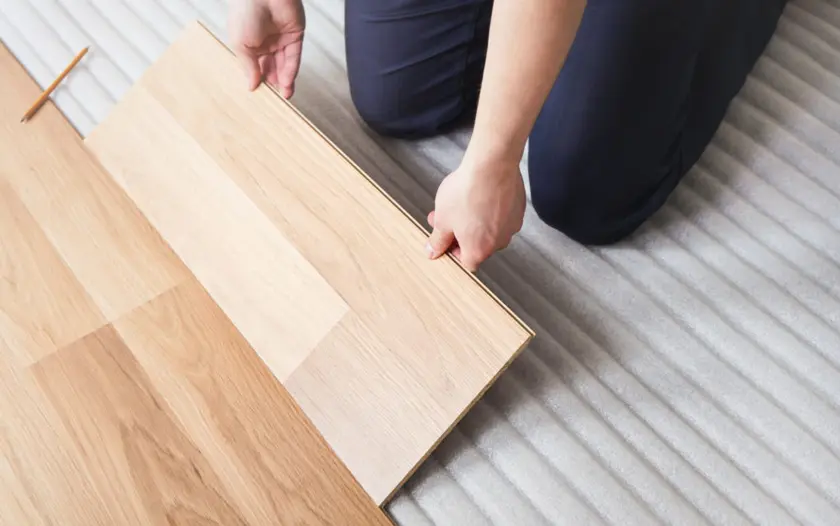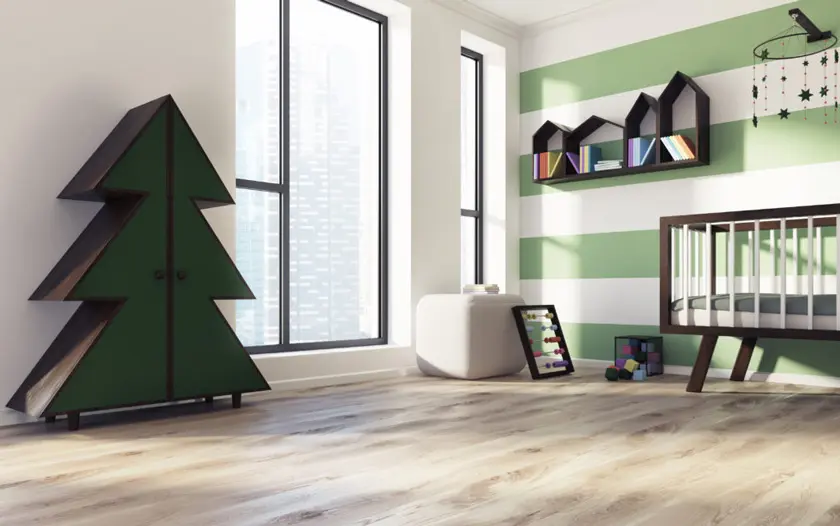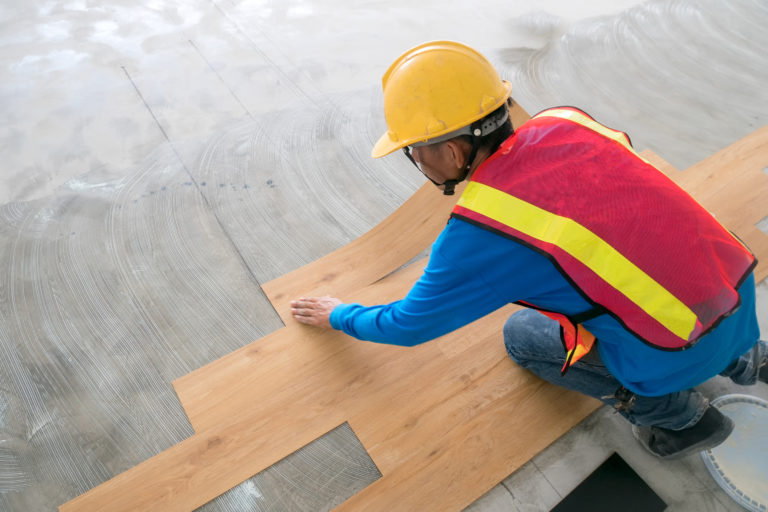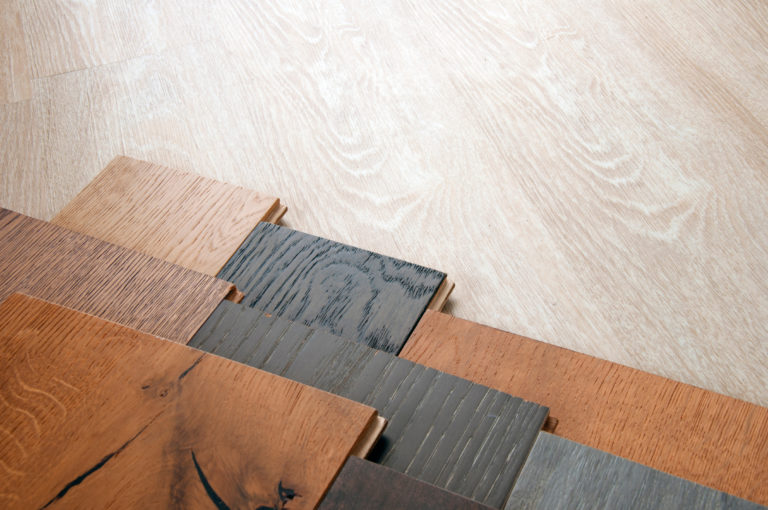In our daily pursuit to make our homes even more beautiful and comfortable, it is important what flooring option we choose. Laminate, while it comes with many advantages, can harbor toxins that impact indoor air quality and our overall health.
In this article, we will shed some light on the importance of non-toxic laminate flooring and address some of the concerns you may have about this topic. This will help you choose laminate flooring to aesthetically enhance your space while also preserving the health of you and your family.
What Are Toxic And Non-Toxic Laminates?
When we talk about non-toxic laminate, we’re referring to laminate made from materials that don’t emit harmful gasses when installed in your home, therefore not compromising indoor air quality. You should look for laminate options free from volatile organic compounds (VOCs) if possible or check if those are kept at an allowed minimum.
The most reliable way to check if your laminate choice falls into this category is if the brand in question is GreenGuard, GreenGuard Gold, or FloorScore certified.

Toxicity of Laminate (VOCs)
As previously stated, many traditional flooring materials contain VOCs such as formaldehyde, benzene, and phthalates. These types of chemicals are often found in heavy industrial adhesives that are used to produce laminate.
Over the years, it has been proven that some cheaply made laminate may contain higher levels of these harmful chemicals. All of these can lead to various health issues, such as respiratory problems, allergies, and skin irritation.
Formaldehyde (the main culprit)
Formaldehyde is a colorless, strong-smelling gas commonly used in the production of various building materials. In laminate flooring, formaldehyde is primarily used in the adhesive resin, typically a urea-formaldehyde or melamine-formaldehyde resin, to bind the layers of the laminate together, providing durability and moisture resistance.
While the finished laminate flooring product contains very low levels of formaldehyde, concerns arise due to the potential off-gassing of this chemical, which can contribute to indoor air pollution and health issues, especially in poorly ventilated spaces.
Off-Gassing
How exactly do these toxic chemicals pollute the air we breathe? This is done and explained through a process known as off-gassing, when chemicals from materials used to produce laminate are released into the air over time. It’s a significant concern for many people today who are wary of indoor air pollution and want to keep it to a minimum. Non-toxic laminate options minimize or eliminate off-gassing, ensuring a healthier environment for everyone.
Best Brands of 2024
How long does this off-gassing last?
This process can even go on for years, depending on the level of VOCs in the product. If you have recently installed laminate flooring, it’s a good idea to keep your windows open for circulation or to even use an air purifier as well.
Should You Worry About Formaldehyde In Your Laminate?
In case you already have installed laminate flooring in your house and are curious to know if it is still a bad decision to leave it be and if it’s better to go about finding a replacement with some of the non-toxic options, don’t be alarmed!
Very often, the amount of formaldehyde in the laminate flooring, if it is present, can vary due to how the flooring is made. This is why most people stay away from cheap laminate brands made in China, for example, since some of them may not be very well regulated and it may prove hard to research their background.
Formaldehyde can affect people differently. Some people are very sensitive to formaldehyde at a certain level, while others may not have any noticeable reaction to the same level. Formaldehyde is just one of several gases present indoors that may cause adverse health effects and illnesses. Several respiratory illnesses, such as colds and the flu, can cause similar symptoms to those caused by formaldehyde.

Tips for Buying Non-Toxic Laminate
Since we covered the potential health risks of laminate floors, let’s help you make the best choice for yourself when buying non-toxic laminate flooring.
Look for Products With a Low Formaldehyde Content (<.03 PPM)
PPM stands for parts per million. It’s a way to measure formaldehyde off-gassing in a given product. According to the Environmental Protection Agency (EPA), non-toxic laminate flooring is defined as a product with a formaldehyde content below .03 ppm. The EPA also recommends that consumers look for products that are labeled TSCA Title VI compliant.
Research and Certifications
When you’re buying non-toxic laminate for yourself, it’s best to conduct thorough research on different materials and brands.
The easiest way is to look for third-party certifications like GreenGuard, GreenGuard Gold, or FloorScore, which guarantee that the laminate you buy is indeed meeting specific indoor air quality standards.
We should also mention the CARB (California Air Resources Board) certificate, but please note that the CARB focuses specifically on formaldehyde emissions from composite wood products, while FloorScore and the others we mentioned address a broader range of VOC emissions from various types of flooring products. All of these certifications are valuable indicators of a product’s low impact on indoor air quality.
When engaging with flooring suppliers, don’t hesitate to ask questions about adhesives, finishes, and any other potential sources of toxins.

Benefits of Non-Toxic Laminate
Choosing a non-toxic laminate goes beyond its well-established aesthetic. These types of laminate promote better respiratory health, especially for those individuals who suffer from allergies or sensitivities, but regardless of our health condition, our well-being and that of our family should not come at the cost of beautiful and aesthetically pleasing floors. For families with children or pets who spend a lot of time close to the floor, non-toxic laminate flooring has become the best alternative to some of the other not-so-environmentally-friendly flooring options.
Non-Toxic Laminate Brands To Look For
Many of the best laminate floor brands make non-toxic laminate flooring—here are some of our top picks.
Newton
Newton steps into the spotlight with its commitment to health and sustainability. Their laminate flooring options are not just a treat for the eyes but also gentle on your indoor air quality. With many of their products boasting European manufacturing and stringent adherence to low VOC emissions, Newton ensures that your living space remains both elegant and environmentally friendly.
AquaGuard
Dive into the world of AquaGuard, where durability meets conscientious living. Known for their robust, water-resistant laminate flooring, AquaGuard also pays close attention to your health. Their products are designed to minimize VOC emissions, safeguarding your indoor air quality while offering a shield against life’s spills and splashes.
Tarkett
These folks are like the guardians of your indoor air quality. They offer a range of low-VOC (volatile organic compounds) laminate flooring, ensuring you can take a deep breath without worrying about nasty chemicals.
Pergo
Known as one of the pioneers in the laminate game, Pergo’s laminates are not just tough but also come with certifications like GreenGuard Gold, meaning they meet rigorous standards for low chemical emissions.
Mohawk
Like a reliable buddy, Mohawk offers laminate flooring that’s not just durable but also healthier. Their products are often backed up by certifications that assure low VOCs and a commitment to indoor air quality.
Shaw
These guys take the cake when it comes to variety and health-conscious options. Many of their products are certified to be low-VOC and are designed to keep your space safe and stylish.
Mannington
If you’re looking for a brand that marries style with sustainability, Mannington is your go-to. They are known for their eco-friendly practices and have a range of laminate options that are FloorScore certified, ensuring good indoor air quality.
Conclusion
Now you know what makes laminate toxic and what non-toxic options are available to you. You learned about the benefits of non-toxic laminate flooring and what brands offer just that.
But remember, while the brand is a good starting point, always check for specific certifications like GreenGuard, GreenGuard Gold, FloorScore, or the NALFA (North American Laminate Flooring Association) seal. These are like superhero badges for non-toxic flooring. And don’t forget, even the best laminate needs a trustworthy sidekick—make sure the underlayment and adhesives are also non-toxic for the complete peace-of-mind package!
About The Author

Steph Gregerson
January 19, 2024
Steph is a book nerd, rule follower, and pizza lover who can't get enough of playing outside. She was raised on the ice rinks of MN and currently resides in sunny San Diego. As a freelance writer, she loves research, producing content, and organizing information for a wide variety of clients. She currently has at least 10 browser windows open at all times.






1 comment
Praful
Hi, Pergo flooring is not GreenGuard Gold certified. But I have heard that they used to be and after acquisition by another company, the acquiring company just does not use that certification. Any insights into this?